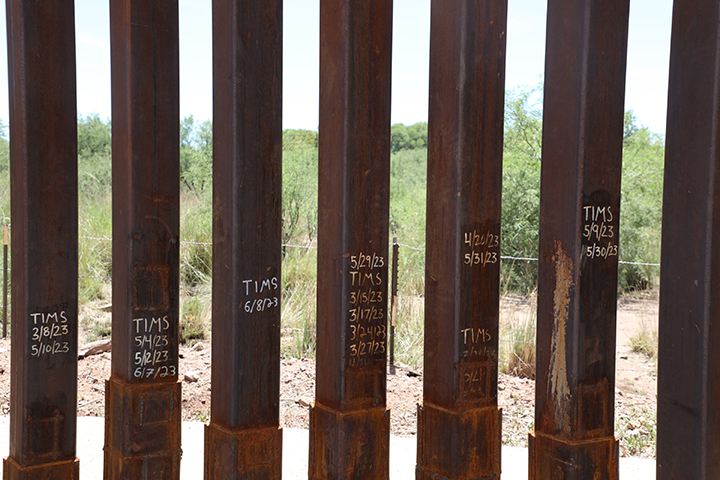The Wall Street Journal’s Evolving Views on “Open Borders”
A November 18 Wall Street Journal editorial details the Biden administration’s feckless immigration policies, and explains how the border will get even worse now that a federal judge has vacated CDC orders directing the expulsion of illegal migrants, which were issued pursuant to Title 42 of the U.S. Code in response to the Covid-19 pandemic. Not so long ago, the paper called for “open borders”, but given the disastrous results of the Biden administration’s experiment with that ideal, it’s time for a much different tack.
Biden’s Border Fiasco, in Brief. By way of background, Joe Biden inherited what Rodney Scott, his first Border Patrol chief, described last September as “arguably the most effective border security in” U.S. history, but the 46th president quickly allowed it to “disintegrate” as “inexperienced political appointees” ignored “common sense border security recommendations from experienced career professionals.”
Border Patrol migrant apprehensions at the Southwest border have soared under Biden: In FY 2021, agents apprehended nearly 1.66 million illegal entrants, a new annual record. The actual number of aliens who entered illegally was much higher, however, as that apprehension total did not include an estimated 389,000 “got-aways”, illegal entrants who successfully evaded agents and entered illegally that fiscal year.
That apprehension record did not stand for long, as agents at the Southwest border apprehended more than 2.2 million illegal migrants in FY 2022, again not counting an estimated 599,000 got-aways last fiscal year.
The humanitarian and national-security disaster at the Southwest border has continued into FY 2023. Last month, agents set a new apprehension record for the month of October, taking into custody more than 204,000 illegal entrants while an additional 64,000 migrants eluded agents to make their way into the United States.
Calling for leadership at the Southwest border, the left-leaning editorial board at Bloomberg Opinion in August termed the situation there “Biden’s Border Fiasco”—a sobriquet that makes clear exactly where the blame lies.
That said, the one body that has failed to recognize the dire consequences at the border is the Biden administration itself. Under Senate questioning on November 17, DHS Secretary Alejandro Mayorkas blamed the entire Western Hemisphere for what’s unfolding at the Southwest border. The secretary also refused to term it a “crisis”, deeming it instead “a significant challenge”.
Ditching Successful Policies. The situation at the border has, in Chief Scott’s terms, “disintegrated” for a very simple reason: Quickly after taking office, Biden ditched nearly all the policies the Trump administration implemented that had brought some semblance of order to the Southwest border.
The most significant of those policies was the Migrant Protection Protocols (MPP), better known as “Remain in Mexico”.
Implemented beginning in December 2018, MPP had allowed agents to return non-Mexican illegal entrants back across the line to await their removal hearings. In an October 2019 assessment of the policy, DHS called Remain in Mexico “an indispensable tool in addressing the ongoing crisis at the southern border and restoring integrity to the immigration system”.
Indispensable or not, then-candidate Joe Biden derided MPP, and as president, Biden first suspended the program and then allowed Mayorkas to terminate it it—twice. In fact, since April 2021, the Biden administration has been fighting an effort by state plaintiffs in federal court to force DHS to reimplement Remain in Mexico (thus far successfully).
Title 42. The one quasi-border policy that the Biden administration left in place was Title 42. The first of those CDC orders was issued shortly after the pandemic was declared in late March 2020, and subsequent orders were issued in October 2020 and, under Biden, in August 2021.
While more than 87 percent of illegal entrants at the Southwest border were expelled pursuant to Title 42 under Trump, the Biden administration has increasingly applied those orders much more sparingly.
About 58 percent of the nearly 1.375 million aliens apprehended by Border Patrol at the U.S.-Mexico line between February and September 2021 were expelled under Title 42, while fewer than 48 percent of the illegal migrants apprehended there were expelled under those CDC orders in FY 2022.
In October, just 37.4 percent of aliens apprehended at the Southwest border were expelled under Title 42, continuing a trend of declining application of those “mandatory” expulsion orders.
Why have expulsions declined? The Biden administration had announced in late March it would end Title 42 effective on May 23—even though DHS warned that as many as 18,000 aliens would enter illegally per day post-Title 42. Before the White House could do so, however, a federal judge in Louisiana enjoined the termination of the CDC orders on May 20.
Thus, the administration has only reluctantly be implementing Title 42 since the spring. While all of this was going on, however, immigrant advocacy groups had been pushing to vacate Title 42 entirely in federal court in D.C.
As the Journal noted, DHS “defended the policy in this case mainly to control the time and manner of its cancellation”. I will note, as an aside, that the department’s effort pushed the end of Title 42 until after the November midterm elections, which determined control of Congress.
That end came following a November 15 ruling by Judge Emmet Sullivan of the U.S. District Court for the District of Columbia, in which he vacated and enjoined CDC’s Title 42 migrant expulsion orders.
Judge Sullivan had wanted that order to take effect immediately, though the next day he acceded to an unopposed request by the administration to stay the end of the program until December 21, in an order he issued “WITH GREAT RELUCTANCE” (capitalization in original).
As a second aside, that means that the full effects of the end of Title 42 will not be felt until two weeks after the Georgia runoff election for U.S. Senate, pitting incumbent Sen. Raphael Warnock (D) against Republican challenger Herschel Walker, on December 6.
The Journal’s Latest Take. Here’s the Journal’s latest take on all of this:
Title 42’s end will compound a border problem already turning worse. Summer usually marks the high point for illegal crossings, but this year migration has kept surging. The number of migrants detained at the border has risen for the past three months and in October it passed 230,000, the third most in DHS history.
Worse, the U.S. has lost Mexico’s aid against migrants. Title 42 was preceded by the Remain in Mexico policy, a deal struck by President Trump to keep asylum claimants south of the border while they awaited U.S. court dates. The Supreme Court in June let Mr. Biden end that policy, and now Mexico says no mas: Its government said last month it won’t hold migrants under the program.
Note that the Journal concludes that the administration’s “vacant U.S. border policy” is both problematic in and of itself and also a hindrance to amnesty for aliens unlawfully present:
It’s a shame because rising illegal crossings are the biggest political impediment to the immigration bargain Democrats claim to want. “Our ultimate goal,” Sen. Chuck Schumer said Wednesday, is “a path to citizenship for all 11 million” migrants in the U.S. A necessary step would be to remind the President that the public demands an orderly, legal flow and not the unchecked crossings that undermine support for an immigration policy compromise.
“There Shall be Open Borders”. The Journal’s concern about the chaos at the U.S. border would have been surprising to readers of the paper at the turn of the 21st century.
The late Robert L. Bartley was the Journal’s editorial page editor for 30 years before stepping down from that position in 2002. On July 3, 2000, he penned a column for the paper titled “Liberty’s Flame Beckons a Bit Brighter”, which began:
As one of this newspaper’s proud little traditions, on the Fourth of July we offer an editorial salute to immigration. Back in the immigration debate of 1984, we proposed a five-word Constitutional amendment: There shall be open borders. We have repeated this periodically since under an editorial headline invoking Liberty’s torch, “The Rekindled Flame.”
Bartley admitted that support for such an ideal in what was and remains a “conservative” outlet “strikes some as odd”, but he argued that it was consistent with the paper’s theme of “free markets and free men”. He also noted that support for open borders was “an ideal”, not “an immediate policy prescription”.
The Reality of Open Borders. In the purely abstract, I suppose, the ideal of “open borders” carries emotional power. Immigration has formed and transformed the nation and is among the fundamental reasons for its greatness.
“Open borders” is no longer an abstract concept, however. Rather, as the more recent Journal editorial suggests, it is de facto U.S. policy under the Biden administration. And the deleterious effects of open borders have been what I would have envisioned back in July 2000, just eight years into my now 30-plus year career in immigration.
Migrants—and migrant children in particular—are suffering grievous harm and unspeakable indignities on the journey to the United States, a fact that has been underreported of late.
Worse, as CBS News reported in October: “At least 853 migrants died trying to cross the U.S.-Mexico border unlawfully in the past 12 months, making fiscal year 2022 the deadliest year for migrants recorded by the U.S. government”. The death toll would have been much higher but for the more than 22,000 Border Patrol search-and-rescues last fiscal year—a fourfold increase over FY 2019.
Agents at that open border are so tied up saving, transporting, processing, and caring for migrant “give-ups” who turn themselves in after crossing illegally in the reasonable expectation that they will be released into the United States that they cannot go after the vast majority of got-aways—which is why there are so many of them now.
Who are those got aways and why are they coming? By definition, we don’t know, but it would be foolish to think they’re all otherwise “law-abiding” people in search of a better life. That agents at the Southwest border apprehended 107 illegal entrants on the terrorist watchlist in the last 13 months is nothing short of a miracle—but also raises the specter of how many weren’t stopped.
Overwhelmed Border Patrol agents are also struggling to stop the flow of drugs that supposedly only come through the ports of entry, with some notable exceptions.
Drug smuggling is a protean endeavor, and the cartels in charge of it are always changing their tactics to improve their results. The open border presents them with opportunities unavailable two years ago, which likely explains rising U.S. overdose rates, at least in part.
Expect all these horrors to compound exponentially once Title 42 ends on December 21. In FY 2022, the fewer than 17,000 Border Patrol agents at the Southwest border apprehended 6,045 aliens per day on average—six times their ability to respond. As noted, that figure is expected to nearly triple once Title 42 ends.
The Wall Street Journal’s two-decade-old call for “open borders” wasn’t meant to be a policy prescription. September 11 revealed, however, why it was not only a bad idea, but a dangerous one. Despite that, open borders are the Biden administration’s unofficial (but de facto) policy and an experiment we’re living through in real time. The results are in, and that experiment’s end is overdue.






